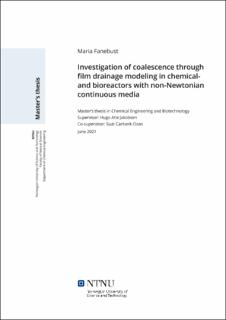| dc.contributor.advisor | Jakobsen, Hugo Atle | |
| dc.contributor.advisor | Ozan, Suat Canberk | |
| dc.contributor.author | Fanebust, Maria | |
| dc.date.accessioned | 2021-10-21T18:24:24Z | |
| dc.date.available | 2021-10-21T18:24:24Z | |
| dc.date.issued | 2021 | |
| dc.identifier | no.ntnu:inspera:82941058:17871005 | |
| dc.identifier.uri | https://hdl.handle.net/11250/2824822 | |
| dc.description.abstract | Denne masteroppgaven tar for seg dreneringen av en ikke-Newtonsk film innfanget mellom to fluidpartikler for å modellere koalesens i kjemiske reaktorer og bioreaktorer. I litteraturen finnes det mange studier som utforsker koalesens i Newtonske kontinuerlige medier. Imidlertid er koalesens i ikke-Newtonske medier langt mindre undersøkt og ennå ikke helt forstått. Dermed, for å bedre forstå dette konseptet, bygges en filmdreneringsmodell som tar ikke-Newtonske kontinuerlige medier i betraktning. Grenseflatene er deformerbare og kan ha hvilken som helst grad av tangential mobilitet. Det ikke-Newtonske fluidet er klassifisert som generalisert Newtonsk og overholder potensloven. Fluidpartiklene kolliderer forsiktig med en konstant tilnærmingshastighet. Hydrodynamisk smøringsteori brukes i tynnfilmgrensen for å forenkle modelligningene, og tangentialhastigheten til grenseflatene bestemmes via grenseintegralmetoden. Gjennom potensindeksen, n, undersøkes effekten av den ikke-Newtonske oppførselen på filmdreneringen og koalesenstiden. Den ikke-Newtonske oppførselen påvirker antall synlige render på grenseflatene betydelig. Imidlertid, når tilnærmingshastigheten er liten og det ikke er noen render på grenseflatene, eller når grenseflatene er helt mobile, ser det ut til at koalesenstiden for ikke-Newtonske og Newtonske kontinuerlige medier er den samme. Ellers fører økende potensindeks til økende koalesenstid. Dermed tar koalesens lengre tid for skjærtykkende fluider enn Newtonske fluider, som igjen tar lengre tid enn skjærtynnende koalesens. Denne ikke-Newtonske effekten forsterkes med avtagende tangentiell mobilitet av grenseflatene og økende relativ tilnærmingshastighet. | |
| dc.description.abstract | This thesis considers the drainage of a non-Newtonian film entrapped between two fluid particles to model coalescence in chemical- and bioreactors. In the literature, there exist numerous studies that explore coalescence within Newtonian continuous media. However, coalescence in non-Newtonian media is far less researched and not yet fully understood. Thus, to better understand this concept, a film drainage model taking non-Newtonian continuous media into account is built. The interfaces are deformable and allowed to have any degree of tangential mobility. The non-Newtonian continuous phase is classified as a generalized Newtonian fluid obeying the power law. The fluid particles collide gently with a constant approach velocity. The lubrication theory is employed in the thin-film limit to simplify the model equations, and the tangential velocity of the interfaces is determined via the boundary integral method. Through the power index, n, the effect of the non-Newtonian behavior on the film drainage and coalescence time is examined. The non-Newtonian behavior is found to affect the number of emerging rims on the interfaces significantly. However, when the approach velocity is small in which there are no rims, or when the interfaces are fully mobile, the coalescence time for non-Newtonian and Newtonian continuous media appears to be the same. Otherwise, increasing power index leads to increasing coalescence time. Thus, coalescence takes a longer time for shear-thickening fluids than Newtonian fluids, which again takes longer than shear-thinning fluid coalescence. This non-Newtonian behavior effect is amplified with decreasing tangential mobility of the interfaces and increasing relative approach velocity. | |
| dc.language | eng | |
| dc.publisher | NTNU | |
| dc.title | Investigation of coalescence through film drainage modeling in chemical- and bioreactors with non-Newtonian continuous media | |
| dc.type | Master thesis | |
